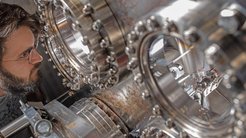Instantaneous Response
Researchers at the TU Munich, the Max Planck Institute of Quantum Optics and the TU of Vienna have succeeded in measuring the precise duration of the photoelectric response.
Modern global networks of communication, solar power generation and distribution, and materials science are ultimately based on the photoelectric effect. More than a century after Albert Einstein explained its nature, research teams at the Technical University of Munich (TUM), the Laboratory of Attosecond Physics (LAP) at the Max Planck Institute of Quantum Optics (MPQ) and the Technical University of Vienna have measured the incredibly short time that elapses between the absorption of a photon by an electron and the resulting emission of the electron from an atom. The measurements identify the factors that contribute to this fundamental process and provide insights into how it can be manipulated.

With the help of vacuum chambersLAP physicists explore the interaction between light and matter. | Photocredits: Heddergott/TUM
When light falls on crystal, it interacts with its electrons. If the incident photons have sufficient energy, and the interaction occurs near the surface of the material, electrons can be detached from the ordered crystal lattice and observed. For decades, researchers have taken advantage of this energy-dependent photoelectric effect to investigate the properties of semiconductors, metals and superconductors. Until now they could only measure the energies and directions of photoemission, while the dynamics of the process itself have remained obscure. However, the absolute duration of the elemental process itself yields important clues relating to the detailed mechanism of emission, such as how the excited electron leaves the crystal lattice, and how other electrons respond to its loss. Due to the minuscule dimensions involved, these issues are poorly understood yet.
With the aid of a newly developed method, an international team of physicists has now determined the absolute duration of the interval between the absorption of an energetic photon and the emission of the photoelectron. The researchers prepared tungsten crystals with single iodine ions on its surface, and irradiated them with ultrashort X-ray pulses to trigger the photoelectric effect. Because the iodine atoms respond to the X-ray-radiation extremely rapidly, they can serve as a stopwatch to measure both the precise arrival time of each pulse and the departure time of the dislodged electron. In order to maximize the precision of these measurements, the iodine stopwatch was synchronized to an absolute reference based on photoemission from helium, which the team described less than 2 years ago (Nature Physics, 7. Nov. 2016). The combination of these techniques enabled the duration of the photoemission process to be determined with an uncertainty of a few attoseconds, i.e. a few billionths of a billionth of a second.
The measurements revealed that photoelectrons can be liberated from a tungsten crystal within the space of 40 attoseconds, about twice as fast as expected. This is partly attributable to the fact that light of certain wavelengths (or colours) interacts exclusively with the atoms in the outermost plane of the crystal. Moreover, the same experiment demonstrated that even this astonishingly fast response can be accelerated. The researchers were also able, for the first time, to characterize the temporal behaviour of single iodine atoms loosely adsorbed on the surface of a host crystal. In fact, such atoms emit electrons without any measurable delay when excited by X-ray-radiation. This discovery has implications for the manufacture of ultrafast photocathodes which, for example, have potential applications in free-electron lasers.
The authors of the new study now plan to use their new method to observe the photoelectric responses of more complicated molecules adsorbed to surfaces. These materials are promising candidates for use in novel, highly efficient solar cells and chemical catalysts. The ability to observe the temporal response of these molecules will make it possible to understand the hitherto unknown processes that define their photochemical properties, which will allow these features to be optimized for specific applications.
